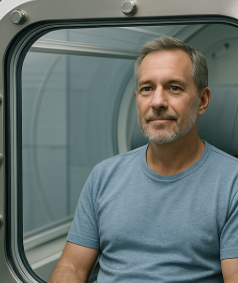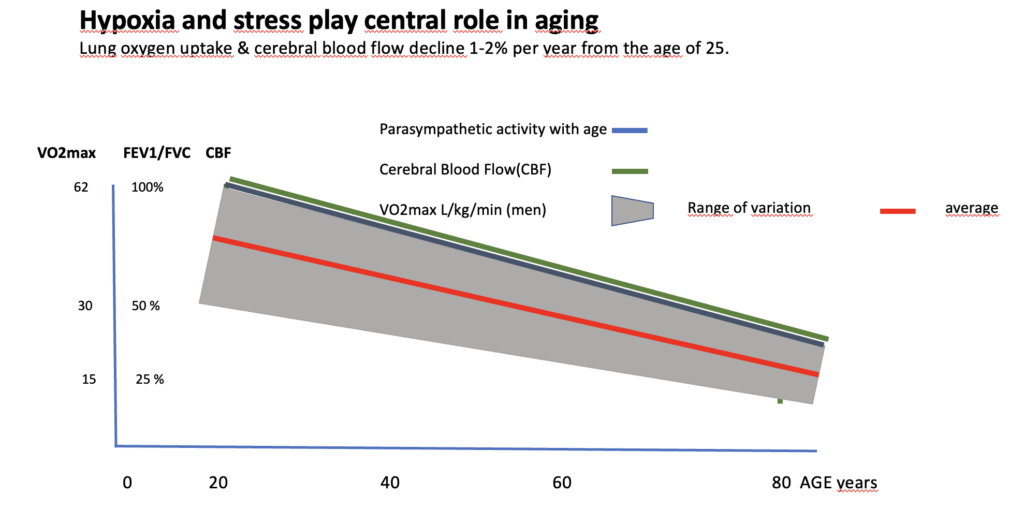
Our HBA treatment involves sitting in a “submarine” in a pressurized space and breathing air for 60 minutes 1-3 times a week.
HBA promotes healthy aging and improves age-related diseases.
A basic requirement for a healthy life and well-being is that our body receives enough energy. This is produced by our body’s miniature batteries, the mitochondria. They convert the nutrients brought to them by our bloodstream into energy with the help of oxygen (O2).
As we age, the amount of energy we receive for use decreases. The best explanation for this is considered to be a disruption in the functioning of our batteries (mitochondria), the important – if not the most important – reason for which is the deterioration of O2 intake (oxygen uptake capacity) and O2 transport.
Both oxygen uptake capacity (lung function) and oxygen transport (blood circulation) deteriorate (1-2% per year, starting at the age of 25).
Initially, the decrease in O2 intake is only evident during exertion, but at >65 years of age, it is often already evident in everyday activities – such as climbing stairs (Figure 1).
Slow, mild and only occurring during exertion, the decline in oxygen supply leads to a mild chronic oxygen deficiency, hypoxia, which in turn creates a mild stress state in the body (overactivity of the sympathetic division of the autonomic nervous system) and a low-grade chronic inflammatory state.
These, together with other known signs of aging, lead to the fact that we not only age but also develop various diseases.
The latest research has shown:
Aging and hypoxia can be equated.
Our autonomic nervous system also regulates our aging in such a way that sympathetic overactivity (stress, overexcitation) accelerates aging changes and causes diseases, while nervous system balance and sufficient parasympathetic activity slow down and prevent these.
Therefore, the basic prerequisites for healthy aging are sufficient access to the elixir of life, oxygen, and stress-free living.
At the Helsinki Center for Healthy Aging (HELTIK), we have developed a treatment program (Healthy Aging Program, HAP) that can effectively address/correct these factors. Its key components are hyperbaric oxygen therapy (HBA) and vagus stimulation.
Our program is unique worldwide.
If you are interested in healthy aging or if you have health problems – e.g. symptoms of cerebral hypoxia or osteoarthritis – you should get in touch.

When sitting in a “submarine” or pressure chamber, and increasing the pressure to 1.75 ATA (bar), the oxygen partial pressure (PaO2) of the blood plasma increases to >100% **
| Sea level | 1.75 bar (ATA) pressure | ||
| 1.0 ATA | HBA | HBOT | |
| air breathing | air breathing | Added oxygen | |
| Atmospheric pressure | 760 mmHg | 1330 mmHg | 1330 mmHg |
| PO2 | 159 mmHg | 227 mmHg | 1330 mmHg |
| *PAO2 | 100 mmHg | 207 mmHg | 910 mmHg |
| *PaO2 | 90 mmHg | 197 mmHg | 890 mmHg |
| PaO2 >64v | 80 mmHg | >160 mmHg | >800 mmHg |
| PaO2 75-85v | 70 mmHg | >160 mmHg | >800 mmHg |
| PO2 = Oxygen pressure in the blood when air enters the nose |
| PAO2 = Oxygen pressure in the blood in alveoli |
| PaO2 = oxygen pressure in the blood, which determines how much oxygen is in the blood that goes to the brain, for example. |
HEI’s hyperbaric chamber is the “sister ship” of MIR 1 and MIR 2. Mir1 and 2 are submarines that were manufactured and sold by Rauma-Repola oy to the Soviet Union after a new innovative steel hardening method was developed. No more sales were made because the CIA banned them (the USA threatened to suspend all trade with Finland).
**O´Reilly et al Measurement of oxygen concentration delivered via nasal cannula by tracheal sampling. Respirology 2014; 19: 538-543.

Symptoms most commonly caused by a lack of oxygen in the brain:
Mild temporary oxygen deprivation in the brain is very common in older people.
The following symptoms are typical examples of temporary or local brain oxygen deprivation:
- Fatigue
- Headache (lasting more than 2–3 hours)
- Balance problems, nausea
- Sleep disturbances, such as difficulty falling asleep, waking up (more than 2 times per night), restless legs
- Fine motor and sensory disturbances
- Brain fog and/or other disturbances of consciousness
If symptoms occur 1-3 times a week, we recommend HBA as a treatment program (60 minutes at 1.75 ATA pressure, breathing air, approx. twice a week).
WE HAVE STARTED A PROJECT IN WHICH PATIENTS WITH BRAIN HYPOXIA SYMPTOMS RECEIVE HBA TREATMENT TWICE A WEEK. THE INITIAL RESULTS ARE VERY PROMISING.
